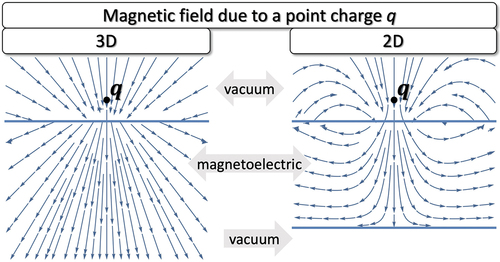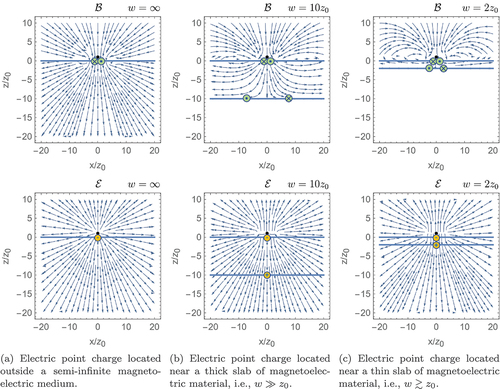Figures & data

Figure 1. Mechanisms underpinning magnetoelectricity in semiconductor-heterostructure quantum wells. Charge carriers can move freely in the plane but are confined in
direction by a symmetric potential arising from the spatially varying conduction-band bottom (drawn in black pen). Equilibrium currents [(a)] and bound-state charge distributions [(b)] are indicated in red. The band bending shown schematically in the right panel of subfigure (a) is due to the applied perpendicular electric field. The qualitatively similar, but typically much smaller in magnitude, band bending arising as a consequence of the magnetic-field-induced electric polarization is not shown in the right panel of subfigure (b).
![Figure 1. Mechanisms underpinning magnetoelectricity in semiconductor-heterostructure quantum wells. Charge carriers can move freely in the xy plane but are confined in z direction by a symmetric potential arising from the spatially varying conduction-band bottom (drawn in black pen). Equilibrium currents [(a)] and bound-state charge distributions [(b)] are indicated in red. The band bending shown schematically in the right panel of subfigure (a) is due to the applied perpendicular electric field. The qualitatively similar, but typically much smaller in magnitude, band bending arising as a consequence of the magnetic-field-induced electric polarization is not shown in the right panel of subfigure (b).](/cms/asset/f15bee39-74a0-473c-8bd6-305439237892/tapx_a_2032343_f0001_oc.jpg)
Figure 2. An electric charge placed near a planar interface (located at
) between an ordinary dielectric (occupying the region
) and a magnetoelectric medium (present in region
) generates image dyons on both sides. The values of their electric (magnetic) charges are related via
(
).

Figure 3. An infinite set of image dyons is needed to describe electric and magnetic fields generated by an electric point charge
placed near [panel (a)] or inside [panel (b)] a finite-width slab of magnetoelectric material. Here
labels dyons arising from mirror-imaging at the upper (lower) boundary,
when the image dyon is located above (below) the
boundary, and
is a counter associated with the dyon location. Dyons with
arise only for the case with
inside the magnetoelectric medium [panel (b)].
![Figure 3. An infinite set of image dyons dkmν is needed to describe electric and magnetic fields generated by an electric point charge q0 placed near [panel (a)] or inside [panel (b)] a finite-width slab of magnetoelectric material. Here m=U(L) labels dyons arising from mirror-imaging at the upper (lower) boundary, ν=+(−) when the image dyon is located above (below) the m boundary, and k∈Z∖0 is a counter associated with the dyon location. Dyons with k<0 arise only for the case with q0 inside the magnetoelectric medium [panel (b)].](/cms/asset/50ea46fd-ddf2-4744-883d-fda2835c401d/tapx_a_2032343_f0003_oc.jpg)
Figure 4. Field lines of the electric () and magnetic (
) fields generated by an electric point charge located outside an isotropic magnetoelectric medium occupying the space
and having the same dielectric constant and magnetic permeability as the surrounding ordinary medium (
,
). The black dot indicates the location of the source charge, and horizontal thick blue lines delineate interfaces between ordinary and magnetoelectric media. Green circles are positioned where the interface-current distribution has maxima and show the current direction. Yellow circles are positioned where the interface-charge distribution has maxima and show its sign. The magnetoelectric is assumed to have
.

Figure 5. Field lines of the electric () and magnetic (
) fields generated by an electric point charge located inside an isotropic magnetoelectric medium occupying the space
and having the same dielectric constant and magnetic permeability as the surrounding ordinary medium (
,
). The black dot indicates the location of the source charge, and horizontal thick blue lines delineate interfaces between ordinary and magnetoelectric media. Green circles are positioned where the interface-current distribution has maxima and show the current direction. Yellow circles are positioned where the interface-charge distribution has maxima and show its sign. The magnetoelectric is assumed to have
.

Figure 6. Field lines of the electric () and magnetic (
) fields generated by an electric point charge located outside an isotropic magnetoelectric medium occupying the space
and having
,
, and
. The black dot indicates the location of the source charge, and horizontal thick blue lines delineate interfaces between ordinary and magnetoelectric media. Green circles are positioned where the interface-current distribution has maxima and show the current direction. Yellow circles are positioned where the interface-charge distribution has maxima and show its sign.

Figure 7. Magnetoelectrically induced interface currents in the slab geometries considered in this work. The blue (yellow) curves show the variation of the current-density component at the upper (lower) boundary as a function of coordinate
. Pairs
of values associated with positive-current maxima are indicated, allowing also the negative-current maxima to be identified via symmetry as
. Panel (a) [(b), (c), (d), (e), (f)] pertains to the situations shown in ) [), ), ), ), )].
![Figure 7. Magnetoelectrically induced interface currents in the slab geometries considered in this work. The blue (yellow) curves show the variation of the current-density component Jy at the upper (lower) boundary as a function of coordinate x/z0. Pairs (x/z0,Jy) of values associated with positive-current maxima are indicated, allowing also the negative-current maxima to be identified via symmetry as (−x/z0,−Jy). Panel (a) [(b), (c), (d), (e), (f)] pertains to the situations shown in Figure 4(b) [Figure 6(b), Figure 5(b), Figure 4(c), Figure 6(c), Figure 5(c)].](/cms/asset/d06bf10e-43dc-4f32-b573-7e9f00978045/tapx_a_2032343_f0007_oc.jpg)
Table B1. The potentials in terms of image charges when the point charge is above the magnetoelectric slab. Note that does not exist by construction
Table B2. The potentials in terms of image charges when the point charge is in the magnetoelectric slab. Note that ,
and
do not exist by construction
